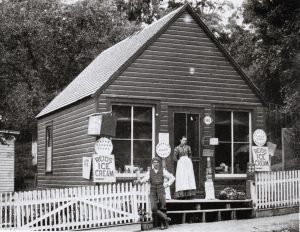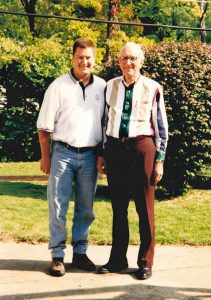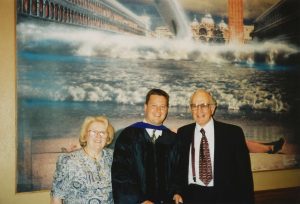By David Dunaief, M.D,

Reflux is common after a large meal. This is when stomach contents flow backward up the esophagus. It occurs because the valve between the stomach and the esophagus, the lower esophageal sphincter, relaxes for no apparent reason. Many incidences of reflux are normal, especially after a meal, and don’t require medical treatment (1).
However, gastroesophageal reflux disease (GERD) is a more serious disorder. It can have long-term health effects, including erosion or scarring of the esophagus, ulcers, and increased cancer risk. Researchers estimate it affects as much as 28 percent of the U.S. adult population (2). No wonder pharmaceutical firms line drug store shelves with over-the-counter and prescription solutions.
GERD risk factors range from lifestyle — obesity, smoking and diet — to medications, like calcium channel blockers and antihistamines. Other medical conditions, like hiatal hernia and pregnancy, also contribute (3). Dietary triggers, such as spicy, salty, or fried foods, peppermint, and chocolate, can also play a role.
One study showed that both smoking and salt consumption increased GERD risk significantly, with increases of 70 percent in people who smoked or who used table salt regularly (4). Let’s examine available treatments and ways to reduce your risk.
What medical options can help with GERD?
The most common and effective medications for treating GERD are H2 receptor blockers (e.g., Zantac and Tagamet), which partially block acid production, and proton pump inhibitors (e.g., Nexium and Prevacid), which almost completely block acid production (5). Both classes of medicines have two levels: over-the-counter and prescription strength. Let’s focus on proton pump inhibitors (PPIs), for which just over 90 million prescriptions are written every year in the U.S. (6).
The most frequently prescribed PPIs include Prilosec (omeprazole) and Protonix (pantoprazole). Studies show they are effective with short-term use in treating Helicobacter pylori-induced peptic ulcers, GERD symptoms, and gastric ulcer prophylaxis associated with NSAID use (aspirin, ibuprofen, etc.) as well as upper gastrointestinal bleeds.
Most of the data in the package inserts is based on short-term studies lasting weeks, not years. The landmark study supporting long-term use approval was only one year. However, maintenance therapy usually continues over many years.
Concerns about long-term usage effects and overprescribing have led to calls among pharmacists to take an active role in educating patients about their risks – along with educating patients about the need to take them before eating for them to work (7).
What are PPI risks?
Side effects after years of use can include increased risk of bone fractures and calcium malabsorption; Clostridium difficile (C. difficile), a serious bacterial infection in the intestines; potential vitamin B12 deficiencies; and weight gain (8).
The FDA has amplified its warnings about the increased risk of C. difficile, which must be treated with antibiotics. Unfortunately, it only responds to a few antibiotics, and that number is dwindling. Patients need to contact their physicians if they develop diarrhea when taking PPIs and the diarrhea doesn’t improve (9).
Suppressing stomach acid over long periods can also result in malabsorption issues. In a study where PPIs were associated with B12 malabsorption, it usually took at least three years’ duration to cause this effect. While B12 was not absorbed properly from food, PPIs did not affect B12 levels from supplementation (10). If you are taking a PPI chronically, have your B12 and methylmalonic acid (a metabolite of B12) levels checked and discuss supplementation with your physician.
Before you stop taking PPIs, consult your physician. Rebound hyperacidity can result from stopping abruptly.
What non-medical options can improve GERD?
A number of modifications can improve GERD, such as raising the head of the bed about six inches, not eating prior to bedtime and obesity treatment, to name a few (11).
Fiber and exercise. The study that quantified the increased risks of smoking and salt also found that fiber and exercise both had the opposite effect, reducing GERD risk (4). An analysis by Journal Watch suggests that the fiber effect may be due to its ability to reduce nitric oxide production, a relaxant for the lower esophageal sphincter (12).
Manage weight. In one study, researchers showed that obesity increases pressure on the lower esophageal sphincter significantly (13). Intragastric (within the stomach) pressures were higher in both overweight and obese patients on inspiration and on expiration, compared to those with a “normal” body mass index.
Avoid late night eating. One of the most powerful modifications we can make to avoid GERD is among the simplest. A study showed a 700 percent increased risk of GERD for those who ate within three hours of bedtime, compared to those who ate four hours or more before bedtime (14).
While drugs have their place in the arsenal of options to treat GERD, lifestyle changes are the first, safest, and most effective approach in many instances.
References:
(1) Gastroenterol Clin North Am. 1996;25(1):75. (2) Gut. 2014; 63(6):871-80. (3) niddk.nih.gov. (4) Gut 2004 Dec; 53:1730-1735. (5) Gastroenterology. 2008;135(4):1392. (6) Kane SP. Proton Pump Inhibitor, ClinCalc DrugStats Database, Version 2022.08. Updated August 24, 2022. Accessed October 11, 2022. (7) US Pharm. 2019:44(12):25-31. (8) World J Gastroenterol. 2009;15(38):4794–4798. (9) FDA.gov. (10) Linus Pauling Institute; lpi.oregonstate.edu. (11) Arch Intern Med. 2006;166:965-971. (12) JWatch Gastro. Feb. 16, 2005. (13) Gastroenterology 2006 Mar; 130:639-649. (14) Am J Gastroenterol. 2005 Dec;100(12):2633-2636.
Dr. David Dunaief is a speaker, author and local lifestyle medicine physician focusing on the integration of medicine, nutrition, fitness and stress management. For further information, visit www.medicalcompassmd.com or consult your personal physician.

























